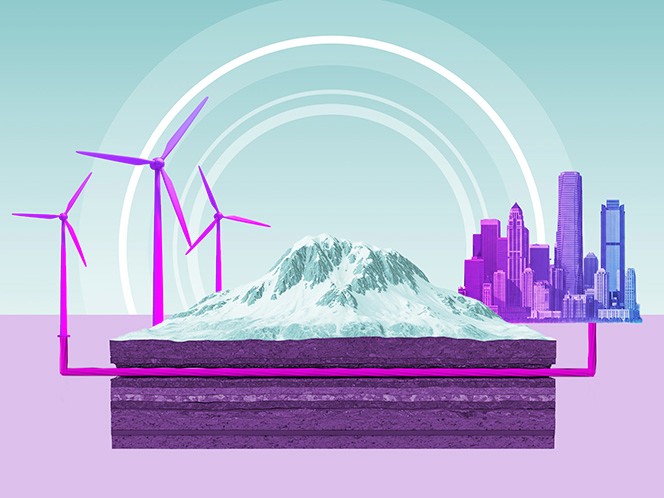Can undergrounding help fix grid transmission?
Posted: May 05, 2025

For years, SunZia has been trying to build a 550-mile transmission line connecting its sprawling wind farms in New Mexico to the grid in Arizona. It’s been called “the largest renewable energy project in U.S. history,” but permitting issues and local opposition to the line have resulted in major delays.
In the Midwest, a near-identical story is playing out over the Grain Belt Express, an 800-mile-long transmission line connecting wind farms in Kansas to population centers like St. Louis and Indianapolis.
These are not isolated cases. One study found that almost half of the transmission projects it investigated in the U.S. faced substantial opposition. Such opposition comes at a time when renewables, EVs and data centers are driving a significant expansion of electrical demand across the United States.
Our Industrial Life
Get your bi-weekly newsletter sharing fresh perspectives on complicated issues, new technology, and open questions shaping our industrial world.
Consulting firm Grid Strategies estimates annual peak demand growth will average 3% per year over the next five years, which “would mean six times the planning and construction of new generation and transmission capacity.”
Amidst this need for expansion, extreme weather events like wildfires and storms are becoming more severe, threatening the electrical infrastructure our world relies ever more totally upon.
All this, coupled with the emergence of new technology, has brought the idea of burying transmission lines underground—long dismissed as expensive and impractical—back onto the agenda.
The evolving economics of undergrounding
While it is commonplace for low-voltage distribution lines in urban areas to be laid underground, the same is not true of long-distance, high-voltage transmission lines.
That’s primarily because when compared to stringing up a cable on a row of pylons, burying power lines has historically been much more expensive—up to 10 times more expensive, according to the California Public Utilities Commission.
But the calculations are changing.
“The cost of not having your grid underground just keeps getting higher and higher as our climate changes,” says Ben Corwin, a VP at undergrounding start-up EarthGrid. “Storms that used to be 500-year, 100-year events now are sometimes annual, sometimes every ten years. Our infrastructure truly was not designed for that.”
Indeed, following the wildfires in California at the beginning of 2025, when overhead lines were notably vulnerable to damage, Gavin Newsom, the state’s governor, issued an executive order to “speed the process of ‘undergrounding’ utility equipment to help communities recover more quickly while building resilience to preventing similar catastrophic fires in the future.” [1]
At the same time as the economic risks associated with overhead lines are rising, the cost of undergrounding is set to fall. Estimates from the utilities in California put the cost of undergrounding at around $2.4 million per kilometer, though they go as high as $4.5 million per kilometer (inflation adjusted).
EarthGrid says it has got the cost down to approximately $1 million per kilometer.
The start-up has achieved this feat thanks to its plasma boring technology, which allows for much smaller tunnels and can penetrate even the hardest rock. Combined, these advantages help address what has, in the past, been one of the biggest contributors to the cost of undergrounding: route planning.
“The routing of a lot of tunnels is actually chosen based on the geology, not whether that's the quickest point from A to B,” Corwin told Our Industrial Life. A more direct route not only makes boring the tunnel cheaper—it reduces cabling and transmission costs. “If we can cut even 10%, 20%, 50% off of the route length by going through hard rock, we've unlocked a type of value that you would never even have considered,” says Corwin.
The technical challenges to undergrounding power lines
“There's a reason why we have ex-Tesla, ex-NASA robot and spaceship geeks on our teams—working in the underground world is not dissimilar to working in space, or automating travel on roadways,” says Corwin. “It's a giant systems problem.”
The U.S. Department of Energy would seem to agree. In January 2024, it announced $34 million in funding for the development of undergrounding innovations. The variety of the projects illustrates the manifold challenges around underground systems.
GE Vernova, for example, received $3.7 million to develop a robotic tunneling worm. Pacific Northwest National Laboratory received the same amount to develop an AI system for turning geophysical data into a digital twin of subterranean landscapes. Honolulu-based Oceanit received $3.3 million to produce a subsurface sensor system to “avoid damaging existing utilities when undergrounding powerlines.”
As these projects suggest, if undergrounding is truly going to take off, keeping track of the new subterranean infrastructure will be of vital importance. Germany is a cautionary tale in this regard: according to reporting by Bloomberg, the country has an estimated 5.7 million kilometers of underground infrastructure cables but no centralized repository of their locations—a predicament that is greatly hindering the country’s $1-trillion green energy push.
The vision for an underground supergrid
Late last year, EarthGrid announced a $18-billion joint venture with EnerTech, an arm of Kuwait’s sovereign wealth fund. According to Corwin, the grand vision behind the collaboration is an underground “supergrid” that would—finally—interconnect the United States’ disparate energy networks.
Coast-to-coast interconnection would go a long way toward maximizing the output and usage of renewable electricity assets, but as the SunZia saga demonstrates, overhead transmission is tough to make happen. The permitting of underground interconnection—especially if achieved with non-toxic, electrically-powered plasma boring tech—promises to be more straightforward.
Plus, the proposed underground supergrid could also ferry other utilities, like the excess heat generated by data centers, from one region to another.
EarthGrid’s powers of persuasion have so far netted it almost $50 million in seed funding. The company’s next round of funding isn’t far away. The outcome of that will give a clearer indication of exactly how close—or far away—the U.S. truly is from the widespread undergrounding of transmission lines.